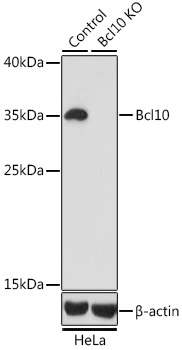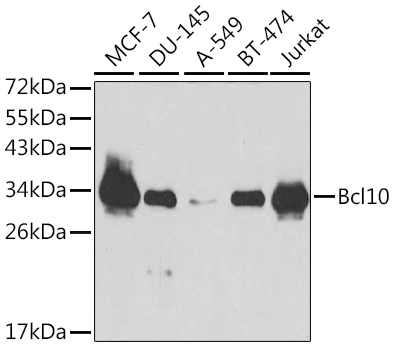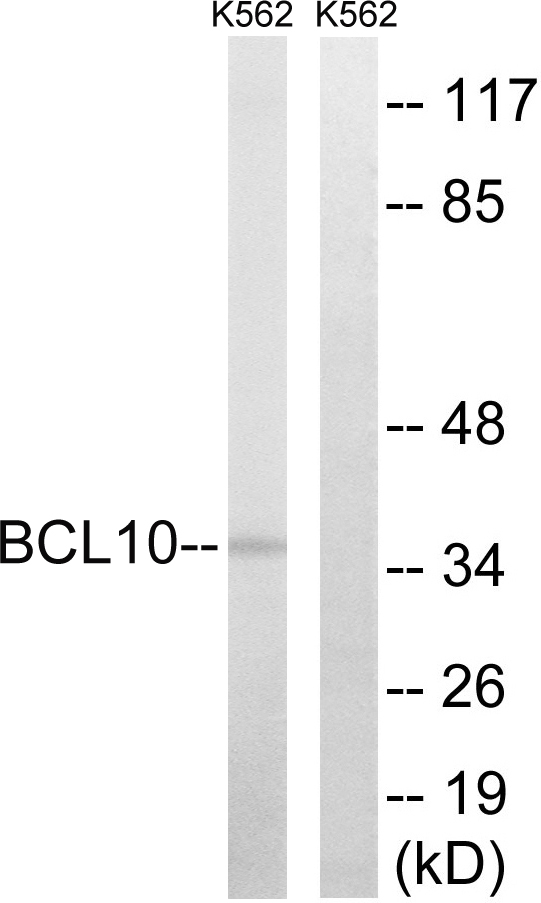
WB analysis of normal (control) and knockout (KO) HeLa cell lysate using GTX55533 BCL10 antibody. Dilution : 1:1000 Loading : 25microg per lane
BCL10 antibody
GTX55533
ApplicationsWestern Blot
Product group Antibodies
TargetBCL10
Overview
- SupplierGeneTex
- Product NameBCL10 antibody - KO/KD Validated
- Delivery Days Customer9
- Application Supplier NoteWB: 1:500 - 1:2000. *Optimal dilutions/concentrations should be determined by the researcher.Not tested in other applications.
- ApplicationsWestern Blot
- CertificationResearch Use Only
- ClonalityPolyclonal
- ConjugateUnconjugated
- Gene ID8915
- Target nameBCL10
- Target descriptionBCL10 immune signaling adaptor
- Target synonymsCARMEN, CIPER, CLAP, IMD37, c-E10, mE10, B-cell lymphoma/leukemia 10, B cell CLL/lymphoma 10, CARD containing molecule enhancing NF-kB, CARD-containing apoptotic signaling protein, CARD-containing molecule enhancing NF-kappa-B, CARD-containing proapoptotic protein, CED-3/ICH-1 prodomain homologous E10-like regulator, cCARMEN, caspase-recruiting domain-containing protein, cellular homolog of vCARMEN, cellular-E10, hCLAP, mammalian CARD-containing adapter molecule E10
- HostRabbit
- IsotypeIgG
- Protein IDO95999
- Protein NameB-cell lymphoma/leukemia 10
- Scientific DescriptionThis gene was identified by its translocation in a case of mucosa-associated lymphoid tissue (MALT) lymphoma. The protein encoded by this gene contains a caspase recruitment domain (CARD), and has been shown to induce apoptosis and to activate NF-kappaB. This protein is reported to interact with other CARD domain containing proteins including CARD9, 10, 11 and 14, which are thought to function as upstream regulators in NF-kappaB signaling. This protein is found to form a complex with MALT1, a protein encoded by another gene known to be translocated in MALT lymphoma. MALT1 and this protein are thought to synergize in the activation of NF-kappaB, and the deregulation of either of them may contribute to the same pathogenetic process that leads to the malignancy. Alternative splicing results in multiple transcript variants. [provided by RefSeq, Mar 2016]
- Storage Instruction-20°C or -80°C,2°C to 8°C
- UNSPSC12352203




![ICC/IF analysis of COS7 cells transiently transfected with BCL10 plasmid using GTX84835 BCL10 antibody [4A8].](https://www.genetex.com/upload/website/prouct_img/normal/GTX84835/GTX84835_1252_ICCIF_w_23061420_781.webp)
![FACS analysis of PFA-fixed K562 cells using GTX34423 BCL10 antibody [BL10/411]. Blue : Primary antibody Red : Isotype control](https://www.genetex.com/upload/website/prouct_img/normal/GTX34423/GTX34423_20200115_FACS_1700_w_23060801_977.webp)
![IHC-P analysis of human tonsil tissue using GTX34424 BCL10 antibody [SPM520].](https://www.genetex.com/upload/website/prouct_img/normal/GTX34424/GTX34424_20200115_IHC-P_1261_w_23060801_120.webp)
